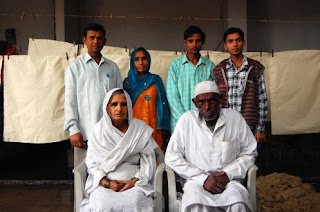A work of Art in the age of Mechanical Production
by Niha Masih
Sanganer is a small, dusty settlement just off the airport road on the outskirts of Jaipur. However the many lanes and by lanes of this neighbourhood throb with life and machinery continuously. One narrow road leads to the renowned blue pottery workshop and another houses textile mills. All open spaces are lined with cardboard drying in the sultry sun. Vigorous screen printing on bedsheets is going on in dingy workspaces.
Originally it was an artisan village populated by the ‘kagazis’ or papermakers. They were the first settlers of Sanganer which interestingly is older than Jaipur. The handmade paper industry had its genesis due to an initiative by Maharaja Sawai Jaisingh II taken as long back as 1728. Over the years it has evolved into an industrial hub with many kinds of factories coming up, from textile to speaker parts. In this mechanized age most of the production in Sanganer’s handmade industry is manual, except for the electric motors used for pulping, calendaring and other peripheral activities.
Till a few years back the whole process of papermaking was manual. At house number 30, Masjid ke pass, Kagazi Colony, it still is.
It is Friday afternoon and Hussain Kagazi Saheb is readying for a bath before the Friday namaz. He does not want to be photographed as he is not wearing his usual pristine white Kurta. His eyes shine with pride and a vigour as he speaks of how he is the only one to have kept alive the art of papermaking in the entire Sanganer. Most of the others have either set up huge factories making close to 1000 sheets daily or have begun other more lucrative businesses. ‘Aisa mazboot kagaz ab kahan milega aapko’, says the 58 year old Kagazi Saheb while scrunching a sheet of paper in his hand. Not a wrinkle or tear.
 The entire family works in tandem during the whole process. Kagazi Saheb creates the paper from pulp while his sons (standing extreme left and second from left) oversee the making of pulp and its cleanliness. The women of the house cook the starch and apply it over paper before finally putting it up for drying. His grandson (standing on extreme right) is still in school and is learning the ropes as yet.
The entire family works in tandem during the whole process. Kagazi Saheb creates the paper from pulp while his sons (standing extreme left and second from left) oversee the making of pulp and its cleanliness. The women of the house cook the starch and apply it over paper before finally putting it up for drying. His grandson (standing on extreme right) is still in school and is learning the ropes as yet.

Zakir Hussain, Kagazi Saheb’s elder son manages the post production aspects like selling and exporting the paper. He is happy being a small producer even though it does not pay as much because it is more satisfying.

The paper production at home was limited and the family got money from the Khadi Gramudyog a few years back to set up a small factory. Unlike most of the other paper making factories their paper is made using all the traditional material,l making it not only strong but also more lasting.

The Kagazis of Sanganer no longer only make paper. The considerable amount of work involving low returns has forced most to shut shop. Many continue to be in the paper business but are into the more lucrative cardboard or cartons business.

In a span of two hours Kagazi Saheb is able to make more than 200 sheets of paper. He says that the entire process is simple but the skill lies in making of the sheet from pulp. That is the secret of a well made paper from an ordinary one. He acquired it from his grandfather and the family now has a 400 year old legacy.
A government agency too approached him offering money to teach this art but he turned it down as he could not bear to ‘sell’ his art. His eyes screw up in hard concentration as he hauls up another sheet from the pulpy water. The flurry of activity around him does not affect his work as he stares deeply into the water. It is not just paper but a part of him in the making.
 Handmade paper can be made from jute, textile or paper. The jute is first cleaned by picking out the fibre by hand.
Handmade paper can be made from jute, textile or paper. The jute is first cleaned by picking out the fibre by hand. The jute is then cut into small, neat bales using a sharp saw.
The jute is then cut into small, neat bales using a sharp saw.




